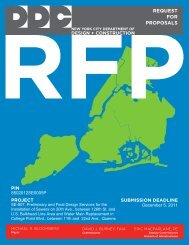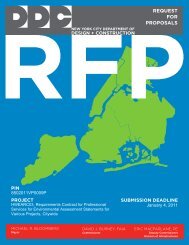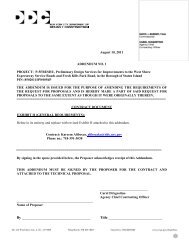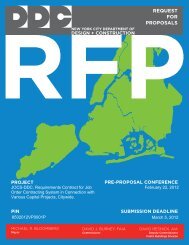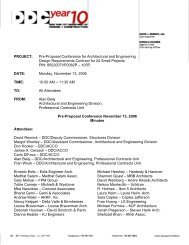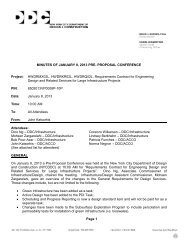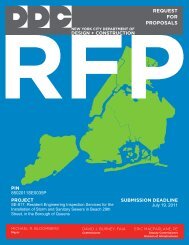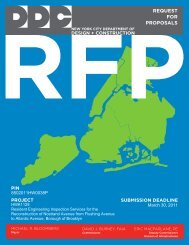requirements contracts for engineering design and related services ...
requirements contracts for engineering design and related services ...
requirements contracts for engineering design and related services ...
You also want an ePaper? Increase the reach of your titles
YUMPU automatically turns print PDFs into web optimized ePapers that Google loves.
11. The Consultant shall prepare a balanced traffic flow map <strong>and</strong> per<strong>for</strong>m levels of service (LOS) analyses using the<br />
latest version of the Highway Capacity Software (HCS) or other software (i.e., CORSIM, AIMSUN, VISSIM, SYNCHRO,<br />
etc.) to be approved by NYCDOT <strong>for</strong> each analysis peak hour <strong>for</strong> the existing <strong>and</strong> future (<strong>design</strong> year with <strong>and</strong> without the<br />
project) conditions. In addition, a balanced traffic flow map <strong>and</strong> LOS analyses <strong>for</strong> estimated time of construction<br />
completion (ETC) shall also be prepared <strong>for</strong> each analysis peak hour. All signalized <strong>and</strong> unsignalized intersections that<br />
are identified <strong>for</strong> operational <strong>and</strong> safety concerns shall be included in LOS analyses. Accordingly, the Consultant shall<br />
recommend appropriate improvement measures as required.<br />
12. The Consultant shall determine the future level of service based on the projection of traffic volumes that are expected<br />
to occur within the estimated time of construction completion plus the expected service life of the project (Design Year).<br />
The Consultant shall use ETC+20 <strong>for</strong> <strong>design</strong> year traffic <strong>for</strong>ecast, unless otherwise directed by the Commissioner. The<br />
New York State Department of Transportation’s (NYSDOT) guidelines shall be followed if the project receives state or<br />
federal funds.<br />
Pavement preventive <strong>and</strong> corrective maintenance as well as safety-<strong>related</strong> work do not usually require the <strong>design</strong> year<br />
traffic <strong>for</strong>ecast. Year ETC+5 peak hour turning movement volumes should be determined <strong>for</strong> proposed signal installations<br />
that will meet the signal warrants in the <strong>design</strong> year, but do not meet the warrants <strong>for</strong> ETC+0.<br />
Future LOS analysis shall be per<strong>for</strong>med <strong>for</strong> both the no-action (future without the project) <strong>and</strong> action (future with project)<br />
conditions. The growth rate, presented in Exhibit 1 of Appendix III of NYCDDC Design Guidelines <strong>and</strong> Directives, used in<br />
determining the projected traffic volumes shall be subject to approval by the Commissioner.<br />
13. The Consultant shall use Mid-LOS “D” <strong>design</strong> criteria <strong>for</strong> project improvements that apply to intersection lane<br />
group(s) rather than the intersection approach or overall intersection. If future operation of a lane group exceeds mid-<br />
LOS “D”, reasonable <strong>and</strong> feasible traffic improvement measures must be recommended so that the lane group is returned<br />
to mid-LOS D in the <strong>design</strong> year without adversely affecting another lane group. Identification of feasible <strong>and</strong> practical<br />
improvement measures should also be guided by NYCDOT’s 2009 Street Design Manual, the detailed guide to the City’s<br />
transportation policies.<br />
14. The Consultant shall submit its draft findings <strong>and</strong> recommendations from the various studies per<strong>for</strong>med under this<br />
task in a Traffic Study report to the Commissioner <strong>and</strong> shall revise the report in accordance with comments provided by the<br />
Commissioner.<br />
15. Upon acceptance of the Traffic Study report by the Commissioner, the Consultant shall incorporate the results<br />
<strong>and</strong> recommendations of the traffic study into the other tasks included in the Specific Requirements <strong>for</strong> the Project.<br />
4.4 HARDWARE AND BASIN CONDITION INVENTORY<br />
1. Under this task the Consultant shall prepare hardware condition inventory of all existing City-owned (includes public<br />
authorities) manholes, catch basins/inlets, valve boxes, seepage basins, etc., <strong>and</strong> all <strong>related</strong> hardware including frames,<br />
adjustment rings, <strong>and</strong> covers within the project limits.<br />
2. The Consultant shall visit the site <strong>and</strong> verify the existence of all City owned hardware (including public authorities)<br />
shown on the topographic survey within the project limits, reconcile any City- owned hardware discrepancies <strong>and</strong> correct<br />
the topographic survey. In addition, the Consultant shall per<strong>for</strong>m a visual inspection of the interior/exterior of all existing<br />
City-owned hardware <strong>and</strong> shall:<br />
i) Identify the Size of manhole covers (not including the frame), condition of manhole covers <strong>and</strong> frames,<br />
material (brick/concrete/other) <strong>and</strong> condition of manhole structures;<br />
ii)<br />
Identify the size <strong>and</strong> type of basins/inlets, with or without curb piece, condition of frame, grating & curb piece,<br />
material <strong>and</strong> condition of basin structures, determine if catch basin has a hood over the connecting pipe;<br />
iii) Identify the Owner/Agency responsible <strong>for</strong> a particular piece of hardware;<br />
NYC Department of Design <strong>and</strong> Construction<br />
Infrastructure, October 2012<br />
GR-25




